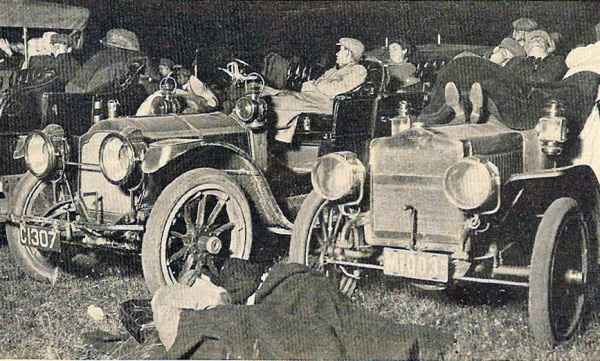Celebrate the 100th Anniversary of the 1910 Vanderbilt Cup Race

Today marks the 100th anniversary of the 1910 Vanderbilt Cup Race held on October 1, 1910. Here's a summary of the last William K. Vanderbilt Jr. Race held on Long Island.
The Vanderbilt Cup Race had a resurgence in 1910 that proved its undoing. Having altered in 1909 their formula of a “rip-roaring, blue-flame snorting” battle of scorchers tearing off the starting line at sunrise, the Vanderbilt Race Commission returned to their roots in 1910. The massive, big-bore racers returned with the break-of-day start that compelled attendees to spend the entire night before in Long Island, drinking and dancing at hotels or around campfires. And although the great European drivers did not return, a new crop of highly skilled American speed demons provided plenty of excitement.
Most spectators arrived again to the race by Long Island Railroad. The huge crowd at the Westbury train station showed the increased interest in the event over the 1909 race. The New York Times estimated the overall crowd was 275,000. Other estimates ranged from 100,000 to a half million.
While the early course configurations approached 30 miles, the 1910 race was compacted into 12.64 miles, the same configuration as the 1909 course. The Long Island Motor Parkway made up only 5.15 miles of that total giving approximately 250,000 people in attendance virtually unrestricted access to 7.49 miles of public roads.
Thirty cars started in the 1910 race, the largest number ever for a Vanderbilt Cup Race. Each car needed to complete 22 laps of the 12.64 mile course for a total of 278.08 miles. In addition, two races were also run simultaneously for smaller, commercially-available stock cars. The Wheatley Hills Sweepstakes had 8 starters and was set for 15 laps or 189.6 miles. The Massapequa Sweepstakes had 6 starters for smaller stock cars and was scheduled for 10 laps or 126.4 miles.
A pit crew awaited a call to action. Each pit was five feet deep and stocked with tools, tires, fuel, oil, water and other supplies to keep each car running smoothly during the race.
The bridges over the Long Island Motor Parkway were popular vantage points for spectators to view the race. The Jerusalem Avenue Bridge was about ½ mile east of the grandstand, which could be seen on the horizon.
The relatively small course and greater number of entries provided many opportunities for cars to compete. The #16 Benz driven by David Bruce-Brown pulled ahead of the #9 Amplex driven by Walter Jones as they approached the Massapequa Lodge. The bridge over Wantagh Avenue was approximately 1/8th of a mile to the west in the background.
Louis Chevrolet’s Marquette-Buick rocketed off the course in Hicksville through a ditch and into a touring car parked in an adjacent yard. Three women were in the car and, amazingly, none were seriously injured. Chevrolet was thrown clear of the accident, the fall inflicting a broken arm but no life threatening injuries. However, his mechanician Charles Miller was pinned under the heavy racer and died on the scene.
Starter Fred Wagner waved the checkered flag as #18 ALCO stormed by to win the 1910 race. American driver Harry Grant’s winning average speed was 65.1 mph, the fastest time ever for a Vanderbilt Cup Race. He completed the 278 miles in 4 hours, 15 minutes and 58.34 seconds. Grant and his ALCO had won the race for the second consecutive time, but the cost to human life was excessive
Two mechanicians were killed and several spectators were injured. In addition to Charles Miller, Chevrolet’s mechanician, Matthew Bacon, the mechanician for driver Harold Stone, was killed in a first lap accident when their Columbia car leaped over the Newbridge Avenue Bridge in East Meadow. Much of the press leveled criticism of reckless disregard for human safety at the race management.
The end finally came to racing for the Cup on Long Island roads. For years the drivers had protested the danger of plunging through the living walls of people during their wheel-to-wheels duels. They were past settling for promises of reform. They simply refused to return to race on Long Island. While William K. Vanderbilt Jr. continued to commission his Cup at other venues through 1916, the heart and soul of the contest died with its disappearance from Long Island.
As a tribute to the 1910 Vanderbilt Cup Race, the 7th Annual Vanderbilt Centennial Celebration will be held on Saturday, October 23, 2010 to Sunday, October, 24, 2010 at the Cradle of Aviation Museum in East Garden City. The events will include demonstration time trials, car shows and my new exhibit "The Incredible Vanderbilt Cup Races Held on the Long Island Motor Parkway (1908-1910". All car clubs are welcome to participate in one of the last events of 2010.
Links to related posts on VanderbiltCupRaces.com:












Comments